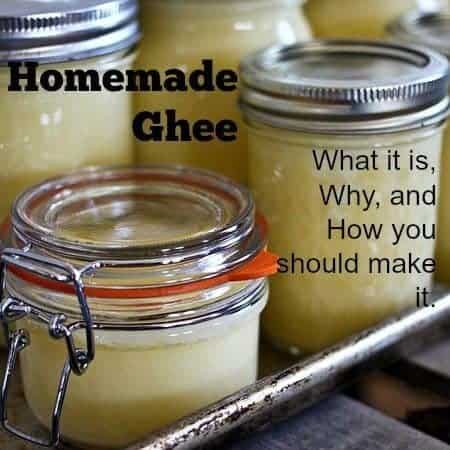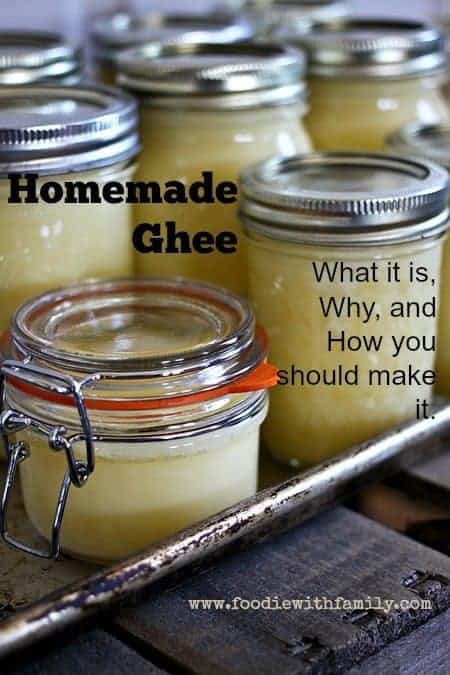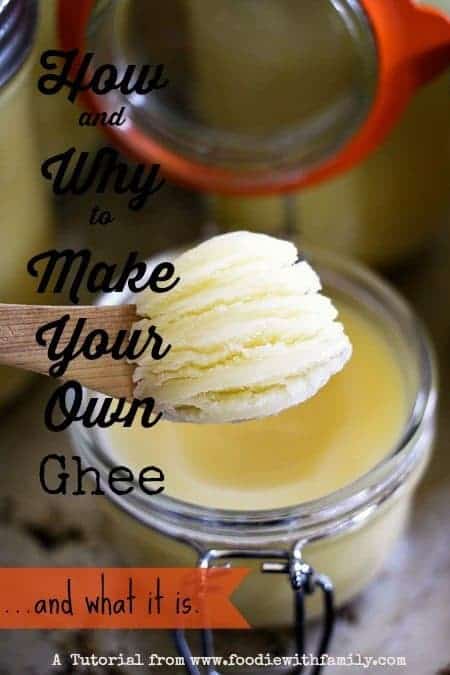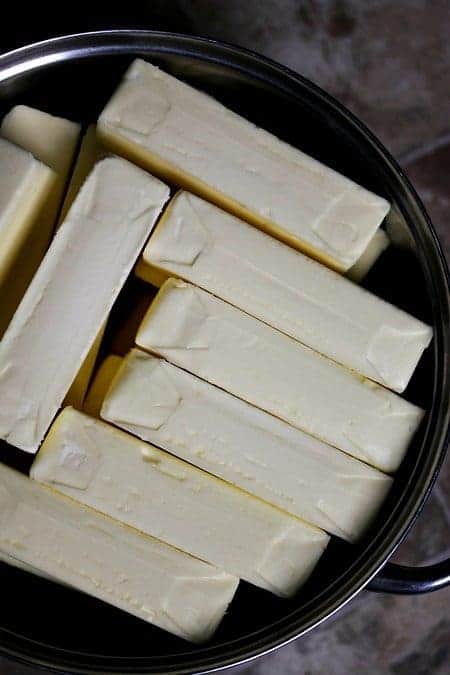Today, I’m sharing a tutorial with you on how to make one of my favourite all-purpose ingredients: Ghee. Some of you are nodding happily and some of you are saying “jee? gee? whuh?” The simplest explanation of what it is could be summed up as “Heaven in a jar”.
What is Ghee?
Ghee, pronounced “gee” with a hard ‘g’- is a form of clarified butter made by melting down butter and cooking it long enough to evaporate the water from it, separate, and then toast the milk solids that naturally occur in butter, leaving behind only pure, golden butterfat. The long, slow cooking process results in a concentrated nutty, toasted butter flavour.
Why Should I Make Ghee?
There is a whole host of reasons why Ghee should always be handy in your pantry/refrigerator/freezer. Among them…
First and foremost, TASTE! Ghee isn’t just for Indian food. It makes the best flavoured fat for frying or scrambling eggs, searing a steak or other cut of meat, sautéeing vegetables or seafood, spreading over freshly baked bread to keep the crust soft, in oatmeal, and just about any other place you’d value a nutty, rich, deep butter flavour.
Having ghee available is like having a handy source of browned butter to add to anything you want. In my estimation, 2/3 of the jobs for which I’d use butter can be done with ghee to great effect.
The clarifying process raises the smoke point of butter from a paltry 250°F to an impressive 485°F. That’s a higher smoke point than peanut oil, canola oil, or vegetable oil. This is why you CAN sear a steak or other meat in it. Regular butter can’t do this without scorching.
It extends the life of butter. Making ghee when you can find large quantities of butter on sale isn’t just a flavour booster.
Regular butter is considered ‘good’ for 1 month after the sell-by date when stored in the refrigerator, or 6 to 9 months after the sell-by date in the freezer. (Source) Ghee can be stored, unopened, in a cool, dark, not-necessarily-refrigerated place for 9 months.
Once opened, a jar can be kept on your counter top for 3 months. Beyond that, the open jar can be stored in the refrigerator for up to 1 year. (Source) A jar of ghee in the freezer at 0°F can be kept indefinitely.
Further down the list for me, but still important is the fact that Ghee is a crucial flavour component to many international cuisines including Indian, Syrian, Lebanese, Persian, Arabic, Pakistani, Georgian, and many others. Even German and French cuisine make use of a version of ghee (Butterschmaltz and Beurre Noisette, respectively.)
It can make butter friendly for those dealing with casein and lactose intolerance. (Source) This does not mean that someone with a true dairy ALLERGY can consume it, but the process of making ghee removes the lactose and casein from the butterfat making it more digestible for someone who experiences unpleasant side effects from eating butter or other dairy.
If you are an adherent to a paleo, GAPS, or real food lifestyle, this is not only acceptable, but is highly recommended as a nutritious dietary fat.
How to Make Ghee at Home:
In short, put a bunch of unsalted butter in a pan on the lowest heat setting you can possibly manage on your stove top then let it go for hours. To expound, occasionally you give it a stir.
If (in the words of Liz of The Lemon Bowl’s Aunt Paula) your butter is smiling at you, you’re doing it right. In other words, you’re not BOILING it, you’re really PERCOLATING it.
It really is that simple. I’d advise you against leaving the house while it’s done, but other than that, you’re really not tethered to it.
When the butterfat has separated out, you skim any foam from the top. Please put that on some toast. You’ll think you’ve died and gone to heaven.
Line a fine-mesh sieve with a flour sack towel or muslin or butter cheesecloth (or a double thickness or muslin or butter cheesecloth for a colander), place it over a heat-safe pitcher or bowl and ladle the ghee into it. This removes any lingering impurities making it keep longer in the jars.
One more important word about Liz’s Aunt Paula! Her post is what inspired me to move from my former small-batch mindset on ghee to thinking big.
Why a large batch had never occurred to me, I couldn’t say, but it makes sense practically to use her method. If you’re going to be rendering down butter for hours on end, you might as well get as much yield out of the energy -whether it be propane, natural gas, or electric- spent on the process as possible, right? Thank you, Aunt Paula!
How to Make Ghee from Butter
The first rule is to start with unsalted butter. There are two main reasons to use unsalted butter to make your ghee.
One: Unsalted butter is generally fresher. Two: Salt concentrates as the ghee is made and can yield an inedibly salty final product.
Ghee Recipe Cook’s Notes:
As mentioned, use only fresh, unsalted butter. Because the flavour concentrates as it cooks, you want a good product at the beginning.
It is important to use a large, heavy-bottomed stock pot or soup pan for making the ghee recipe. The heavy bottom helps keep the temperature even and helps prevent the milk solids from scorching as they fall to the bottom.
You don’t need to stir constantly, but you should stir well occasionally, scraping the bottom of the pan to keep the milk solids from completely adhering to the bottom of the pan.
This is because you don’t want it to scorch. They will settle there, but if you keep them from cementing there, your overall ghee will taste better.
Count on the volume of your butter being reduced by at least 25% overall. For instance, if you begin with 10 pounds of butter (which is the equivalent of 20 cups), you can assume you will end up with 15 cups or so, or possibly less depending on the beginning moisture content of your butter. This is because you’re cooking the water content out of the fat.
You’ll know the ghee is done when it is clear, deep golden butter fat, smells nutty, and has a layer of toasted milk solids at the bottom of the pan. You may find your ghee has a layer of foam floating at the top.
This is fine. It will all be removed when you strain it.
Can I Store Ghee at Room Temperature?
A word on storage: Both Liz’s Aunt Paula and many other resources recommend storing the finished, jarred, cooled ghee in a cool, dark room for long term storage. If you choose to do this, I highly recommend that you sterilize your jars (CLICK HERE to learn how to do that.) before decanting the ghee into them.
I have a basement that never rises above 56°F in temperature even in the dog days of summer. Even so, I’m not sure I’m comfortable with that. I store my ghee in the refrigerator or freezer.
If you’re in the south or somewhere particularly humid, you will definitely wish to choose the refrigerator or freezer for long term storage. Be aware that most food preservation authorities recommend the freezer for long term storage, but make your own informed choice.
Now, I do believe I’ve covered it all. Let’s make some ghee so we can all say, “Ghee, my kitchen smells terrific!”
How to Make Ghee
Unwrap and add all of the butter to a large, heavy-bottomed stockpot. Place the stockpot over the lowest heat you can manage on your cooktop.
If you have a low-powered simmer burner, it is ideal for this job. Melt down the butter and let it cook for 4-6 hours, stirring every so often, until there is a layer of deep, golden, clear, pure butter fat with toasted solids at the bottom of the pan and possibly some foam floating on top.
Do not BOIL the butter! The low heat should keep it steadily percolating at an extremely low simmer, but not boiling.
Line a fine-mesh sieve with a clean piece of muslin or flour-sack towel. If you don’t have a fine-mesh sieve, you can line a colander with a double thickness of muslin or a flour-sack towel.
Position this over a heat-proof pitcher or large bowl. Ladle the butter into the lined sieve or colander. When it has all strained, pour it into the jars to within 1/2-inch of the top. Wipe the rims, fix lids in place and let cool completely before labeling and storing.

Homemade Ghee: How and Why You Should Make It, and What It Is
Rate RecipeIngredients
- 4 to 10 pounds of butter
- sterilized jars with tight fitting lids preferably canning jars with new 2 piece lids
- 1 large heavy-bottomed stockpot
Instructions
- Unwrap and add all of the butter to a large, heavy-bottomed stockpot. Place the stockpot over the lowest heat you can manage on your cooktop. If you have a low-powered simmer burner, it is ideal for this job. Melt down the butter and let it cook for 4-6 hours, stirring every so often, until there is a layer of deep, golden, clear, pure butter fat with toasted solids at the bottom of the pan and possibly some foam floating on top. Do not BOIL the butter! The low heat should keep it steadily percolating at an extremely low simmer, but not boiling.
- Line a fine-mesh sieve with a clean piece of muslin or flour-sack towel. If you don't have a fine-mesh sieve, you can line a colander with a double thickness of muslin or a flour-sack towel. Position this over a heat-proof pitcher or large bowl. Ladle the butter into the lined sieve or colander. When it has all strained, pour it into the jars to within 1/2-inch of the top. Wipe the rims, fix lids in place and let cool completely before labeling and storing.
Nutrition
Nutritional information is an estimate and provided to you as a courtesy. You should calculate the nutritional information with the actual ingredients used in your recipe using your preferred nutrition calculator.
did you make this recipe?
Make sure to tag @foodiewithfam on Instagram and #hashtag it #foodiewithfamily so I can check it out!






Reader's Thoughts...
Renea says
Do you all store it in the frig? What’s the shelf life? If I try this, I would want to make quite a bit as my free time is limited so I wouldn’t be able to repeat this process on a weekly basis. Thank you for any input!
Rebecca says
Hi Renea- I store some in the refrigerator and some in the freezer. 🙂 In the fridge, you’re good for a couple of months. In the freezer, you’re good for 6-8 months.
Susanne Tewes says
I make homemade butter from my Dexter Zebu cross I salt it and it makes the most amazing clarified butter and Ghee you could ever imagine. So you can make salted clarified butter and Ghee and no odd flavor
kathleen worth says
how long does it take to set i made mine finished 6 0clock stored in a place under a press still yellow in colour
Rebecca says
Hi Kathleen- I’m not sure what you mean by set or by placing it under a press. Could you expound?
Natara says
Question: What do you do (or anyone else for that matter) with all that you’ve strained out of the finished product?
Rebecca says
I personally like it on toast. 🙂 It’s nutty and delicious. But you can save it and toss it into pasta as a sauce, too!
Darlene says
nutrition for what amount, tsp, tbsp, or cup ty
George S. says
A picture of what you consider a fine meshed sieve (vs. some weird micron measurement) would be helpful. Also I’ve never seen muslin at a grocery store – not sure I would recognize it or where to look for it). I have a meshed “tea strainer” that I sometimes use if my coffee filter malfunctions, but am not sure if that Is fine enough. Thanks!
Dayle says
I live in Arizona. I notice when I leave the butter on the counter (I don’t have the air conditioner on yet) it separates and there is an amount of clear liquid in the container. Is this considered ghee or do I have to cook it for hours to get ghee?
Rebecca says
Hi Dayle- What you have is clarified butter which is slightly different than ghee. It’s still pretty awesome, though!
Skip says
Does it make a difference whether you use unsalted or salted butter to make the ghee? What is the net amount of ghee you get when finished?
Rebecca says
Hi Skip- I used unsalted butter because I think it is a more pure product to begin with. As for net yield, I am sorry to say I don’t remember. It has been quite a few years since I last made ghee and I don’t have my notes any more. I’m so sorry!
Caitlin says
Hi,
This looks great, going to try tomorrow.
I have three questions.
1) Can I use and cheese cloth
2) Since using unsalted butter can I add salt to recipe for a salty taste? If so at which point would I do this?
3) Could I use a slow cooker/ croc pot?
Thanks
Rebecca says
Hi Caitlin- Let’s see here. I’m not sure what question one is… are you asking whether you can use cheesecloth? It might be a little too loose a weave to strain out the solids… If you make multiple layers (we’re talking at least 4) it might work. I would not add any salt, personally, instead adding salt when using the ghee. And I have not tried this recipe in a slow cooker, crock pot. My hesitancy here would be that you have much finer control over the heat and adjusting it on a stove top.
Dave says
Can you use a number 4 coffee filter to strain the ghee into containers?
Rebecca says
Hi there, Dave. I’m afraid I can’t help you with that because I don’t drink coffee and I’m not sure what a number 4 filter is. 🙂 If you give it a go, please let me know how it works out for you.
Susanne Tewes says
Yes but it will be really slow
Helen Thiessen says
Hi Rebecca, I was just reading you recipe and I was wondering do you strain everything from the pot? The layer at the bottom as well?
Rebecca says
Hi Helen- I do strain everything. 🙂
Yvette grant-barnes says
Can the butter be cooked in a crockpot
Rebecca says
Hi Yvette- I have not tried it, but I’d hesitate to say yes because you have far more control over the heat on a stovetop rather than with a slow cooker. The slow cooker has one set temperature and you can’t really change that!
Judi WIEMERSLAGE says
I have a question, can I substitute coffee filters to strain the ghee?
Šophia says
I use Unsalted European Butter to make Ghee..it has less water and more fat content.
Tracy Tubbe says
Can this ghee be canned and if so would u pc? And for how long
Rebecca says
Hi Tracy- I would probably not at this point, knowing what I know about the stability of fats in the canning process. I’d opt for freezing for longer term storage.
Elaine Jacobe says
I have lactose intolerance I read labels and stay away from whey and lactose. Will I be able to tolerate ghee?
Rebecca says
Hi Elaine- If you have a true medical intolerance, I would confer with your doctor or a nutritionist before trying ghee. I am neither of those, but just repeating what I have learned about it, so I’m not comfortable giving you a firm yes or no.
Susanne Tewes says
The lactose is in the milk and all the milk is removed I have friends who are lactose intolerant that I make Ghee for Ask a Doctor or a food expert but my friends have no trouble it is pure butterfat
Edward Hahn says
When I was young my mum made this on a wood stove in south Texas . We had a dairy farm and access to Jersey cow milk ( couple of hundred gallons daily). We lived on butter and mum sold hundred s of pounds a year. Mum cooked fish in ghee and you will never taste a better crappie than that.Reading the oven way beats the rust of the wood stove way. Thanks
Rebecca says
Boy does that fish ever sound delicious!!! Thanks so much for sharing your story and taking the time to leave a review. It is much appreciated!
Linda Smith says
you have given the best directions for preparation and reasons for use of Ghee. Thank you
Rebecca says
Thanks so much, Linda!
Marjorie says
I thank you soo much for this recipe and method for making ghee
I didnt have a clue what was ghee
Thank you for enlightening my darkness
and i am going to try making ghee next week
God bless you
Erin says
Love making homemade ghee! Great article!
Rebecca says
Thanks so much, Erin!